Floating Debris Clean-up Project
Some of the world’s largest trash deposits, composed of metal, glass, paper, cloth, rubber, wood, and lost, and abandoned or discarded fishing nets, exist in our oceans and waterways. However, plastics such as water and soda bottles and jugs, plastic bags, bottle caps, and foam food containers account for most of this garbage. The National Ocean and Atmospheric Administration’s Marine Debris Program estimates that it would take 67 ships one year to clean up less than one percent of the North Pacific Ocean. This global issue not only has economic and ecologic impacts, but it is also preventable.
Project Goal: Research sources and types of floating trash in a local waterway. Develop and test a prototype of a device or other remotely controllable addition that will allow your SeaPerch to pick up the garbage. Your device should account for and overcome extreme marine conditions while not posing risk to ocean life and protected species and not being a hazard to navigation.

